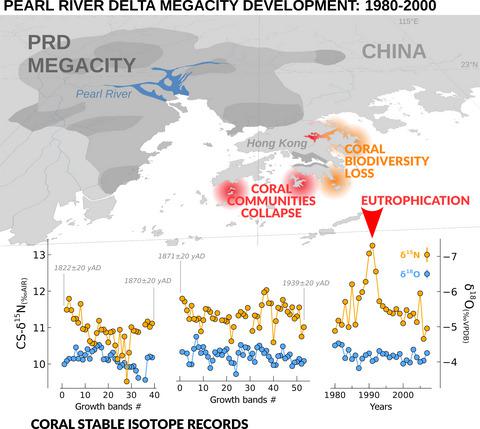当前位置:
X-MOL 学术
›
Glob. Change Biol.
›
论文详情
Our official English website, www.x-mol.net, welcomes your feedback! (Note: you will need to create a separate account there.)
Megacity development and the demise of coastal coral communities: Evidence from coral skeleton δ15 N records in the Pearl River estuary.
Global Change Biology ( IF 11.6 ) Pub Date : 2019-11-15 , DOI: 10.1111/gcb.14923 Nicolas N Duprey 1, 2, 3 , Tony X Wang 4, 5 , Taihun Kim 2, 3 , Jonathan D Cybulski 2, 3 , Hubert B Vonhof 1 , Paul J Crutzen 1 , Gerald H Haug 1 , Daniel M Sigman 4 , Alfredo Martínez-García 1 , David M Baker 2, 3
Global Change Biology ( IF 11.6 ) Pub Date : 2019-11-15 , DOI: 10.1111/gcb.14923 Nicolas N Duprey 1, 2, 3 , Tony X Wang 4, 5 , Taihun Kim 2, 3 , Jonathan D Cybulski 2, 3 , Hubert B Vonhof 1 , Paul J Crutzen 1 , Gerald H Haug 1 , Daniel M Sigman 4 , Alfredo Martínez-García 1 , David M Baker 2, 3
Affiliation

|
Historical coral skeleton (CS) δ18 O and δ15 N records were produced from samples recovered from sedimentary deposits, held in natural history museum collections, and cored into modern coral heads. These records were used to assess the influence of global warming and regional eutrophication, respectively, on the decline of coastal coral communities following the development of the Pearl River Delta (PRD) megacity, China. We find that, until 2007, ocean warming was not a major threat to coral communities in the Pearl River estuary; instead, nitrogen (N) inputs dominated impacts. The high but stable CS-δ15 N values (9‰-12‰ vs. air) observed from the mid-Holocene until 1980 indicate that soil and stream denitrification reduced and modulated the hydrologic inputs of N, blunting the rise in coastal N sources during the early phase of the Pearl River estuary urbanization. However, an unprecedented CS-δ15 N peak was observed from 1987 to 1993 (>13‰ vs. air), concomitant to an increase of NH4 + concentration, consistent with the rapid Pearl River estuary urbanization as the main cause for this eutrophication event. We suggest that widespread discharge of domestic sewage entered directly into the estuary, preventing removal by natural denitrification hotspots. We argue that this event caused the dramatic decline of the Pearl River estuary coral communities reported from 1980 to 2000. Subsequently, the coral record shows that the implementation of improved wastewater management policies succeeded in bringing down both CS-δ15 N and NH4 + concentrations in the early 2000s. This study points to the potential importance of eutrophication over ocean warming in coral decline along urbanized coastlines and in particular in the vicinity of megacities.
更新日期:2020-01-17

























 京公网安备 11010802027423号
京公网安备 11010802027423号